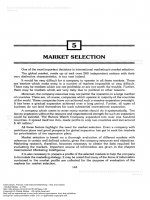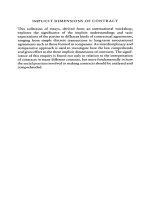International marketing strategy and theory ch12
Bạn đang xem bản rút gọn của tài liệu. Xem và tải ngay bản đầy đủ của tài liệu tại đây (56.13 KB, 17 trang )
Chapter 12
Channels of
Distribution
Chapter Outline
Direct
and Indirect Selling Channels
Types of Intermediaries: Direct Channel
Types of Intermediaries: Indirect Channel
Channel Development
Channel Adaptation
Channel Decisions
Chapter Outline
-
Determinants of Channel Types
Legal Requirements
Product Image
Product Characteristics
Middlemen's Loyalty and Conflict
Local Customs
Power and Coercion
Control
Chapter Outline
Distribution
in Japan
Selection of Channel Members
Representation Agreement and Termination
Black Market
Gray Market
Distribution of Services
Direct & Indirect
Selling Channels
INDIRECT
SELLING CHANNELS
- selling through home-country intermediaries
- simple and inexpensive
- lack of marketing control
Direct & Indirect
Selling Channels
DIRECT
SELLING CHANNELS
- direct contact with overseas intermediaries or
consumers
- requiring more time and cost
- better control
Agent vs. Merchant
Taking
possession vs. taking title (ownership)
Compensation: profit/loss vs.
fee/commission
Employee vs. independent contractor
Agent
may
or may not take possession
never taking title
compensation: commission
more difficult to terminate relationships
Merchant
may
or may not take possession
always taking title
compensation: profit/loss
easier to terminate relationships
Types of Intermediaries:
Direct Channel
Foreign
Distributor
Foreign Retailer
State-Controlled Trading Company
End User
Types of Intermediaries:
Indirect Channel
Export
Broker
Manufacturer's Export Agent or Sales
Representative
Export Management Company (EMC)
Cooperative Exporter
Purchasing/Buying Agent
Country-Controlled Buying Agent
Types of Intermediaries:
Indirect Channel
Resident
Buyer
Export Merchant
Export Drop Shipper
Export Distributor
Trading Company
Channel Decisions
Channel
–
Number of times a product changes hands among
intermediaries
Channel
–
width
Number of middlemen at a particular point in the
channel
Number
–
length
of channels
Single channel vs. dual/multiple channels
Determinants of Channel Types
Legal
Requirements
Product Image
Product Characteristics
Middlemen's Loyalty and Conflict
Local Customs
Power and Coercion
Control
Representation Agreement and
Termination
paying
attention to agency termination laws
having agreements in writing
avoiding evergreen contract
Gray Market
Causes
–
Price differential
Legal
–
Dimension
Protecting independent U.S. trademark owner
Ethical
Dimension
Product Quality
Gray Marketing: Manufacturers’
Strategies
Identifying
and punishing offenders
Educating consumers
Standardized worldwide price
Multiple brands









